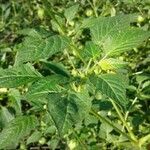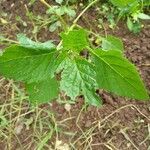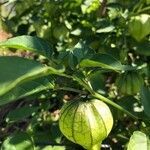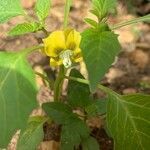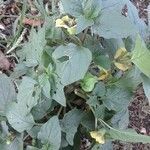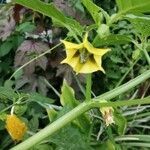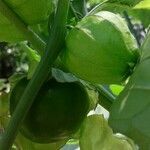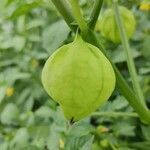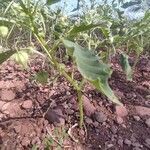Annual to 50 cm, sparsely pubescent with simple hairs. Leaves alternate, 1 or 2 per node (but not opposite); lamina ovate-lanceolate, obtusely cuneate at base, up to 12 (usually c. 6) cm long, sparsely and irregularly toothed; petiole to 7 cm long with a pubescent groove above. Pedicels 3–13 mm long. Calyx 6–9 mm long; lobes broadly triangular, usually 4–5 mm long. Corolla rotate, 10–15 mm long, yellow with 5 brownish spots alternating with anthers. Anthers 3–4 mm long, twisted after anthesis. Style 8–9 mm long. Fruiting calyx 10-veined, circular in section or nearly so, 18–36 mm long, yellow-green, the veins often purplish. Berry globular, usually 20–25 mm diam. Seeds broadly reniform, 2–3 mm long, pale yellow-brown.
Sparsely puberulent annual; stems to c. 60 cm tall, tending to sprawl. Lvs petiolate. Lamina 3-14 × 1.5-10 cm, lanceolate to ovate-lanceolate, glabrate but margins puberulent, strongly dentate to entire; base cuneate, usually ± obliquely so; apex acute to short-acuminate. Fls solitary. Calyx puberulent on ribs, otherwise glabrous; teeth 2-8 mm long, triangular-acute. Corolla (15)-20-40 mm diam., yellow with purplish brown base; teeth short, obtuse. Anthers c. 2-4 mm long, bluish violet. Fruiting calyx to c. 3 cm diam., 10-ribbed, glabrous. Berry 15-25 mm diam., yellow; flesh sweet. Seeds 1.7-2.3 mm diam., broadly ellipsoid to suborbicular.
Herbs annual. Stems branched, glabrescent or sparingly pubescent. Petiole 3-8 cm, densely pubescent; leaf blade broadly ovate, 3-8 × 2-6 cm, glabrescent or sparsely pubescent, base cordate, often oblique, margin usually unequal dentate, apex acute. Pedicel 3-8 mm, glabrescent. Calyx campanulate, divided to halfway. Corolla pale yellow, spotted in throat. Anthers bluish to purplish, 2-3 mm. Fruiting calyx green, ovate, 2-3 × 2-2.5 cm, weakly 5-angled, slightly invaginated at base, often completely filled by fruit. Berry green, yellow, or purplish, globose, ca. 1.2 cm in diam. Seeds discoid, ca. 2 mm in diam. Fl. May-Aug, fr. Aug-Nov.
This herb is an annual plant in temperate regions and a perennial plant in the tropics. It is a soft wooded creeping plant. It can be 1 m high. The branches are purple, spreading and covered with fine hairs. The leaves are heart shaped and nearly opposite. They are 6-15 cm long. They are slightly velvety. The flowers are bell shaped and hang down. They occur in the axils of leaves. They are yellow with purple spots. The fruit buds occur after 12-13 stem internodes have formed. The fruit is covered with a straw coloured husk. The fruit is a berry with smooth waxy skin. It is orange-yellow. The juicy pulp contains small yellow seeds.
Branching annual 2–6 dm, nearly glabrous except on the younger parts, where it is strigillose, often in 2 strips, with decurved hairs; lvs ovate or rhombic, 2–6 cm, entire to sinuate-toothed; pedicels at anthesis 3–5 mm, scarcely longer in fr; cor 7–15 mm, with dark center; anthers blue-purple, mostly 2.5–3.5 mm, becoming twisted or contorted; fruiting cal rounded at base; berry edible, purplish, viscid, nearly filling the cal; 2n=24. Native of Mexico, occasionally escaped from cult. in our range. (P. ixocarpa)
